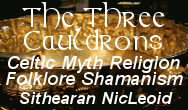Pagan Paths
"Explore ways in which you can easily deepen and sharpen your own practical magic by incorporating methods of divination and spirit-work. There's a little something for everyone in this hoodoo gumbo!" Explore ways to add enchantment to your life and expand your Paganism beyond the basics. Learn how to mine the rich traditions of folklife for new magical practices, and add new depth to your rituals with living folklore.
Enchanted Eating: Foodways & Folk Magic
I recently read an online post about Japanese food in which the author’s grandmother advised her to chew her first bite of rice eighty-eight times. The process of taking rice from seed to tongue apparently takes eight-eight steps, including the agricultural growing process, harvesting, processing, cooking, and so forth. Chewing eighty-eight times is a way, then, of showing respect to the rice, the farmers, the cooks, and so forth.
I have long been interested in what author Margaret Visser calls “the rituals of dinner” in the book of the same title. Visser has penned several tomes on the anthropological construction of mealtimes, including the aforementioned Rituals of Dinner and Much Depends on Dinner, and she dives into everything from good table manners (children pack their mouths with food because as infants they had taste sensors in their cheeks, for example) to utensil choice to throwing dinner parties to deciding to prepare food oneself or to have it prepared (and take the chance that someone might intentionally poison it). Perhaps my favorite chapter in Rituals, however, is “Dinner is Served,” in which she looks at hand-washing, dinner bells, the role of “tasters” (to avoid those pesky poisons), and most importantly, noticing the food, the host or hostess, the other diners, and other atmospheric elements. Such notice, and the natural expressions of appreciation which accompany it, have become the traditions of saying “grace” or “thanks” for the meal before eating.
We have passed Thanksgiving, and are moving towards the winter holidays at rapid speed. I come from a culture where saying grace before a meal is simply “what’s done,” and while it usually comes with Christian overtones or contexts, the leader of the prayer is solely responsible for its content. Much gets made of the idea of saying grace even within Pagan communities, by way of offering thanks to the plants and animals who have given their lives that we might live, and that we might show appreciation to the gods for the blessing of another meal in the company of those we love. I love the quiet moment of grace before a meal, myself, and find that food is seldom foremost on my mind during such prayers. Instead, the consumption of bodily nourishment becomes secondary to the nourishment provided by gratitude and awareness.
Beyond grace, what can we do to add levels of spiritual meaning and enchantment to our meals? I like the idea of the extended fletcherizing of the rice, but rice is only an occasional component of a dinner for me. At first, I thought about looking for new rituals to incorporate into my own foodways to “make” them magical. I realized quickly, however, that I actually have a very active repertoire of Pagan & magical foodways which have been established over a lifetime of eating:
· When my wife and I roast a chicken, we search for the “oysters” on the back of the bird and each give one to the other – Love magic
· Turkeys are searched for wishbones, and wishes made when they snap – Wish magic
· When canning, the “pop” of the sealing lids must be quickly answered with a “thank you!” - Animism
· Plates are set at the table and doors left unlocked during holiday meals, to account for wandering strangers in need of a meal (living or otherwise) – Honoring the dead
· Bones (or shells in the case of crabs, shrimp, etc.) are frozen and reused to make stock, ensuring nothing goes to waste – Honoring the sacrifice made to nourish us (also money magic, considering what we save on buying stock)
· Whoever finds the bay leaf in a meal receives good luck – Luck magic
· Spilled salt must be tossed over the left shoulder to “blind the devil” – Protection magic
Foodways clearly play a large part in my life, then. I would wager, though, that such enchantments exist in most people’s eating practices, if they look hard enough. This holiday season, rather than burden you with the idea that you should graft on additional methods of magic to enchant your mealtime, I’d like to suggest that you take stock of your own “rituals of dinner” and figure out what magical role they play in your life. I’ll bet there are more foodways around your table than you think, and that means the opportunities for enchantment remain ever-abundant. And for that, I give thanks.
Best wishes, and happy holidays,
-Cory
Comments
-
Please login first in order for you to submit comments



















